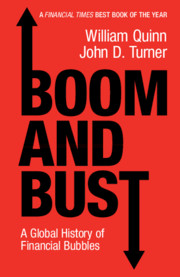Book contents
- Boom and Bust
- Boom and Bust
- Copyright page
- Contents
- Figures
- Tables
- Chapter 1 The Bubble Triangle
- Chapter 2 1720 and the Invention of the Bubble
- Chapter 3 Marketability Revived: The First Emerging Market Bubble
- Chapter 4 Democratising Speculation: The Great Railway Mania
- Chapter 5 Other People’s Money: The Australian Land Boom
- Chapter 6 Wheeler-Dealers: The British Bicycle Mania
- Chapter 7 The Roaring Twenties and the Wall Street Crash
- Chapter 8 Blowing Bubbles for Political Purposes: Japan in the 1980s
- Chapter 9 The Dot-Com Bubble
- Chapter 10 ‘No More Boom and Bust’: The Subprime Bubble
- Chapter 11 Casino Capitalism with Chinese Characteristics
- Chapter 12 Predicting Bubbles
- Acknowledgements
- Notes
- Bibliography
- Index
Chapter 11 - Casino Capitalism with Chinese Characteristics
Published online by Cambridge University Press: 06 August 2020
- Boom and Bust
- Boom and Bust
- Copyright page
- Contents
- Figures
- Tables
- Chapter 1 The Bubble Triangle
- Chapter 2 1720 and the Invention of the Bubble
- Chapter 3 Marketability Revived: The First Emerging Market Bubble
- Chapter 4 Democratising Speculation: The Great Railway Mania
- Chapter 5 Other People’s Money: The Australian Land Boom
- Chapter 6 Wheeler-Dealers: The British Bicycle Mania
- Chapter 7 The Roaring Twenties and the Wall Street Crash
- Chapter 8 Blowing Bubbles for Political Purposes: Japan in the 1980s
- Chapter 9 The Dot-Com Bubble
- Chapter 10 ‘No More Boom and Bust’: The Subprime Bubble
- Chapter 11 Casino Capitalism with Chinese Characteristics
- Chapter 12 Predicting Bubbles
- Acknowledgements
- Notes
- Bibliography
- Index
Summary
Chapter 11 examines the stock market bubbles which occurred in China in 2007 and 2015. Between the end of 2005 and October 2007, the stock market soared by over 400 per cent. One year later, the market had fallen by 70 per cent. Similarly, in the year before June 2015, the stock market had increased by more than 150 per cent. It then collapsed by more than 50 per cent in under three months. The chapter discusses how, in the space of 20 years, China went from having almost no marketability to having heavily controlled marketability, and then near-free marketability. China also went from having virtually no middle class to having the world’s largest middle class, which then became the new speculating class. Thanks to margin lending, they were able to borrow heavily to finance their investments. Both bubbles are very clear examples of how and why governments engineer bubbles in the first instance. In 2007 the Chinese authorities needed to stimulate privatisation and in 2015 they needed to unwind the largest economic stimulus in history.
Keywords
- Type
- Chapter
- Information
- Boom and BustA Global History of Financial Bubbles, pp. 193 - 209Publisher: Cambridge University PressPrint publication year: 2020



